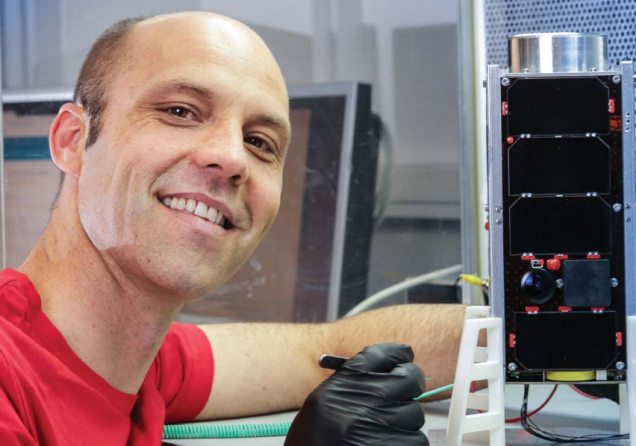
Dr Matthew Tetlow and the solar-powered CubeSat : University of Adelaide
Early this morning Australian time, the first Aussie-built satellites to be launched for 15 years left terra firma from Cape Canaveral in Florida.
One of the tiny nanosatellites, or CubeSats, was built at University of Adelaide and is being delivered along with two other locally-made devices by NASA on an Atlas V rocket bound for the International Space Station.
After approximately a month at the ISS, the devices will be deployed into the thermosphere. The thermosphere, which extends from about 95 km to between 500 and 1,000 km above the Earth, is a layer of the atmosphere we don’t know a lot about.
University of Adelaide’s CubeSat is equipped to take various measurements to enable researchers to better understand the thermosphere’s relationship to other layers, and how that impacts on climate.
“With the miniaturisation of electronics, it’s now possible to put the same amount of research equipment of a full-sized satellite into something that’s about the size of a loaf of bread,” said Research Fellow Dr Matthew Tetlow, who led the project. “The CubeSat can do the same work that a large satellite does at a much reduced cost.”
To power all the instruments, CubeSats uses solar cells to charge lithium-ion batteries. Generating sufficient electricity is quite a challenge due to the small surface area available, an area that also needs to be shared with other gadgets.
Given the space constraints and harsh environmental conditions for operation, solar cells used on CubeSats and modern satellites generally are much more robust and have a substantially higher conversion efficiency than those commonly used in rooftop solar panels.
There are high hopes for a treasure trove of data to be generated by the nanosatellites – and quickly. Dr. Tetlow earlier stated that on the first day of the deployment of the CubeSats into orbit, scientists will be able to double their understanding of the thermosphere.
The CubeSats will remain in Earth’s orbit from six months to two years.
The satellites are part of a European-funded project called QB50, which is comprised of 36 CubeSats studying the thermosphere.
The development of University of Adelaide’s nanosatellite, named SUSat, was supported by the South Australian Government’s Premier’s Research and Industry Fund.. The other two Australian-built devices were developed at University of Sydney (INSPIRE-2) and UNSW (UNSW-EC0).

 RSS - Posts
RSS - Posts



Speak Your Mind